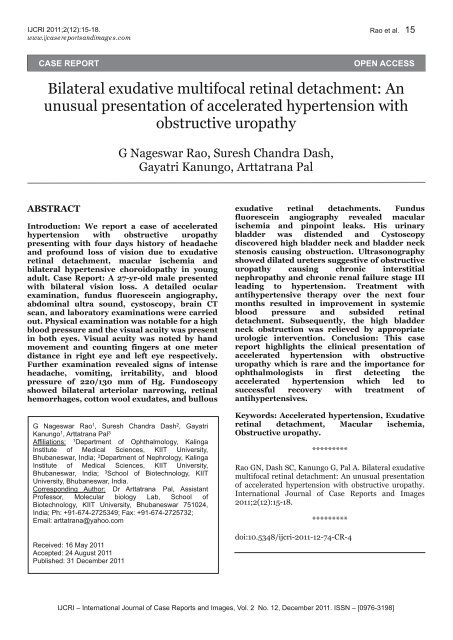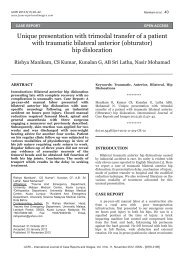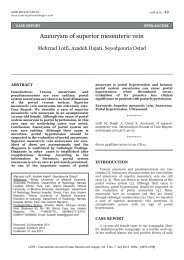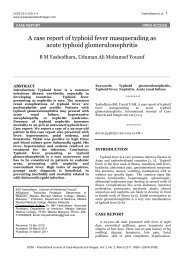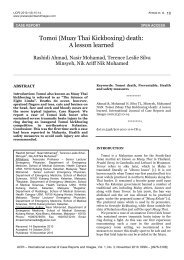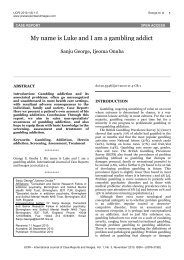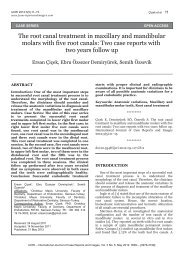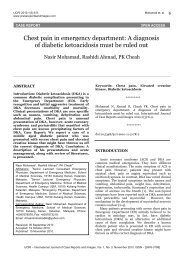Bilateral exudative multifocal retinal detachment - International ...
Bilateral exudative multifocal retinal detachment - International ...
Bilateral exudative multifocal retinal detachment - International ...
You also want an ePaper? Increase the reach of your titles
YUMPU automatically turns print PDFs into web optimized ePapers that Google loves.
IJCRI 2011 ;2(1 2):1 5-1 8.<br />
www.ijcasereportsandimages.com<br />
Rao et al. 1 5<br />
CASE REPORT<br />
OPEN ACCESS<br />
<strong>Bilateral</strong> <strong>exudative</strong> <strong>multifocal</strong> <strong>retinal</strong> <strong>detachment</strong>: An<br />
unusual presentation of accelerated hypertension with<br />
obstructive uropathy<br />
G Nageswar Rao, Suresh Chandra Dash,<br />
Gayatri Kanungo, Arttatrana Pal<br />
ABSTRACT<br />
Introduction: We report a case of accelerated<br />
hypertension with obstructive uropathy<br />
presenting with four days history of headache<br />
and profound loss of vision due to <strong>exudative</strong><br />
<strong>retinal</strong> <strong>detachment</strong>, macular ischemia and<br />
bilateral hypertensive choroidopathy in young<br />
adult. Case Report: A 27yrold male presented<br />
with bilateral vision loss. A detailed ocular<br />
examination, fundus fluorescein angiography,<br />
abdominal ultra sound, cystoscopy, brain CT<br />
scan, and laboratory examinations were carried<br />
out. Physical examination was notable for a high<br />
blood pressure and the visual acuity was present<br />
in both eyes. Visual acuity was noted by hand<br />
movement and counting fingers at one meter<br />
distance in right eye and left eye respectively.<br />
Further examination revealed signs of intense<br />
headache, vomiting, irritability, and blood<br />
pressure of 220/130 mm of Hg. Fundoscopy<br />
showed bilateral arteriolar narrowing, <strong>retinal</strong><br />
hemorrhages, cotton wool exudates, and bullous<br />
G Nageswar Rao 1 , Suresh Chandra Dash 2 , Gayatri<br />
Kanungo 1 , Arttatrana Pal 3<br />
Affiliations: 1<br />
Department of Ophthalmology, Kalinga<br />
Institute of Medical Sciences, KIIT University,<br />
Bhubaneswar, India; 2<br />
Department of Nephrology, Kalinga<br />
Institute of Medical Sciences, KIIT University,<br />
Bhubaneswar, India; 3<br />
School of Biotechnology, KIIT<br />
University, Bhubaneswar, India.<br />
Corresponding Author: Dr Arttatrana Pal, Assistant<br />
Professor, Molecular biology Lab, School of<br />
Biotechnology, KIIT University, Bhubaneswar 751 024,<br />
India; Ph: +91 -674-2725349; Fax: +91 -674-2725732;<br />
Email: arttatrana@yahoo.com<br />
Received: 1 6 May 2011<br />
Accepted: 24 August 2011<br />
Published: 31 December 2011<br />
<strong>exudative</strong> <strong>retinal</strong> <strong>detachment</strong>s. Fundus<br />
fluorescein angiography revealed macular<br />
ischemia and pinpoint leaks. His urinary<br />
bladder was distended and Cystoscopy<br />
discovered high bladder neck and bladder neck<br />
stenosis causing obstruction. Ultrasonography<br />
showed dilated ureters suggestive of obstructive<br />
uropathy causing chronic interstitial<br />
nephropathy and chronic renal failure stage III<br />
leading to hypertension. Treatment with<br />
antihypertensive therapy over the next four<br />
months resulted in improvement in systemic<br />
blood pressure and subsided <strong>retinal</strong><br />
<strong>detachment</strong>. Subsequently, the high bladder<br />
neck obstruction was relieved by appropriate<br />
urologic intervention. Conclusion: This case<br />
report highlights the clinical presentation of<br />
accelerated hypertension with obstructive<br />
uropathy which is rare and the importance for<br />
ophthalmologists in first detecting the<br />
accelerated hypertension which led to<br />
successful recovery with treatment of<br />
antihypertensives.<br />
Keywords: Accelerated hypertension, Exudative<br />
<strong>retinal</strong> <strong>detachment</strong>, Macular ischemia,<br />
Obstructive uropathy.<br />
*********<br />
Rao GN, Dash SC, Kanungo G, Pal A. <strong>Bilateral</strong> <strong>exudative</strong><br />
<strong>multifocal</strong> <strong>retinal</strong> <strong>detachment</strong>: An unusual presentation<br />
of accelerated hypertension with obstructive uropathy.<br />
<strong>International</strong> Journal of Case Reports and Images<br />
2011;2(12):1518.<br />
*********<br />
doi:10.5348/ijcri20111274CR4<br />
IJCRI – <strong>International</strong> Journal of Case Reports and Images, Vol. 2 No. 1 2, December 2011 . ISSN – [0976-31 98]
IJCRI 2011 ;2(1 2):1 5-1 8.<br />
www.ijcasereportsandimages.com<br />
Rao et al. 1 7<br />
Figure 3: A, B) Four months post treatment; Fundus<br />
photographs showing greyish scars and resolution of<br />
hemorrhages, cotton wool spots and <strong>retinal</strong> <strong>detachment</strong>.<br />
Figure 2: A, B) Fluorescein angiography shows the marked<br />
hyperfluorescence from the deep layers of the <strong>retinal</strong> pigment<br />
epithelium in the peripapillary area and peripheral fundus, C)<br />
Fluorescein angiography demonstrated marked irregularity in<br />
the foveal avascular zone and absence of foveal capillaries<br />
(macular ischemia).<br />
recanalization takes place. The early ocular<br />
manifestation includes disturbances of the <strong>retinal</strong><br />
pigment epithelium and choroid with accompanying<br />
<strong>retinal</strong> vascular manifestations (hemorrhages and<br />
cotton wool exudates). In the early phase of<br />
choroidopathy, the fundus exhibits pale white or yellow<br />
patches (acute Elschnig’s spots) corresponding to area of<br />
hyperperfusion of underlying choriocapillaries resulting<br />
from fibrinoid necrosis [3, 4]. There may be a<br />
subsequent breakdown of outer blood <strong>retinal</strong> barrier<br />
and focal posterior pole serous <strong>detachment</strong>.<br />
However, there are a few isolated case reports in<br />
literature where <strong>exudative</strong> <strong>retinal</strong> <strong>detachment</strong> is a<br />
presenting feature. Malhotra et al. [5] described similar<br />
presenting features in a young female with bilateral<br />
renal artery stenosis. Pierro L et al., [6] and de Venecia<br />
G et al. [7] reported a case of <strong>exudative</strong> <strong>retinal</strong><br />
<strong>detachment</strong> in previously diagnosed case of<br />
renovascular hypertension. Chronic obstructive<br />
uropathy cause chronic interstitial nephropathy which<br />
leads to chronic kidney damage as kidneys are exposed<br />
to repeated infection and high intra renal hydrodynamic<br />
pressure. They may be silent in most cases except for<br />
frequency of urine and polyuria. It may produce severe<br />
hypertension which is renin dependent [7]. However,<br />
obstructive uropathy usually presents with flank pain,<br />
urinary tract infection, fever, difficulty while urination,<br />
nausea or vomiting. But in our case the patient<br />
presented with bilateral <strong>exudative</strong> <strong>retinal</strong> <strong>detachment</strong><br />
which led to the diagnosis of obstructive uropathy with<br />
secondary hypertension within four days duration. In<br />
this scenario we are emphasizing here the role of the<br />
ophthalmologist in first detecting a case of secondary<br />
IJCRI – <strong>International</strong> Journal of Case Reports and Images, Vol. 2 No. 1 2, December 2011 . ISSN – [0976-31 98]
IJCRI 2011 ;2(1 2):1 5-1 8.<br />
www.ijcasereportsandimages.com<br />
hypertension and quick management of the patient's<br />
complaints. It is also clearly demonstrated that<br />
ophthalmic manifestations do not need any specific<br />
treatment other than controlling blood pressure. Good<br />
comprehensive examination of the patient can lead to a<br />
systemic diagnosis and control of systemic parameters<br />
will help in improving associated ophthalmic features.<br />
CONCLUSION<br />
In conclusion, our case indicates that accelerated<br />
hypertension may precipitate massive spontaneous<br />
bilateral <strong>exudative</strong> <strong>retinal</strong> <strong>detachment</strong> in patient with<br />
obstructive uropathy in young adults within four days.<br />
Obstructive uropathy in young adults should also be<br />
included in the list of systematic risk factors for<br />
spontaneous <strong>exudative</strong> <strong>retinal</strong> <strong>detachment</strong> of short<br />
duration. It is confirmed that bilateral <strong>exudative</strong> <strong>retinal</strong><br />
<strong>detachment</strong> is a catastrophic event that results in<br />
devastating vision loss within very short span of time<br />
due to accelerated hypertension with obstructive<br />
uropathy.<br />
REFERENCES<br />
Rao et al. 1 8<br />
1. Vaziri ND. Malignant or Accelerated Hypertension.<br />
West J Med 1984;140(4):57582.<br />
2. Kishi S, Tso MO, Hayreh SS. Fundus lesions in<br />
malignant hypertension. A pathologic study of<br />
experimental hypertensive choroidopathy. Arch<br />
Ophthalmol 1985;103(8):118997.<br />
3. Isaacs TW, Acheson JF. Reversible visual failure due<br />
to <strong>exudative</strong> <strong>retinal</strong> <strong>detachment</strong>s in a patient with<br />
uncontrolled systemic hypertension. J Roy Soc Med<br />
1994;87:557558.<br />
4. Klein BA. Ischaemic infarcts of the choroid (Elschnig<br />
spots). Am J Ophthalmol 1968;66:106974.<br />
5. Malhotra SK, Gupta R, Sood S, Kaur L, Kochhar S.<br />
<strong>Bilateral</strong> renal Artery Stenosis Presenting As<br />
Hypertensive Retinopathy & Choroidopathy. Indian<br />
J Ophthalmol 2002;50(3):2213.<br />
6. Pierro L, Pece A, Camesasca F, Brancato R.<br />
Hypertensive Choroidopathy. A case report. Int<br />
Ophthalmol 1991;15(1):914.<br />
7. de Venecia, Jampol LM. The eye in accelerated<br />
hypertension II. Localized serous <strong>detachment</strong>s of the<br />
retina in patients. Arch Ophthalmol 1984;102(1):68<br />
73.<br />
*********<br />
Author Contributions<br />
G Nageswar Rao – Conception and design, Acquisition<br />
of data, Analysis and interpretation of data, Drafting the<br />
article, Final approval of the version to be published<br />
Suresh Chandra Dash – Acquisition of data, Analysis<br />
and interpretation of data, Revising the article critically<br />
for important intellectual content, Final approval of the<br />
version to be published<br />
Gayatri Kanungo – Acquisition of data, Analysis of data,<br />
Revising the article critically for important intellectual<br />
content, Final approval of the version to be published<br />
Arttatrana Pal – Conception and design, Analysis and<br />
interpretation of data, Drafting the article, Critical<br />
revision of the article, Final approval of the version to be<br />
published<br />
Guarantor<br />
The corresponding author is the guarantor of<br />
submission.<br />
Conflict of Interest<br />
Authors declare no conflict of interest.<br />
Copyright<br />
© G Nageswar Rao et al. 2011; This article is distributed<br />
under the terms of Creative Commons attribution 3.0<br />
License which permits unrestricted use, distribution<br />
and reproduction in any means provided the original<br />
authors and original publisher are properly credited.<br />
(Please see www.ijcasereportsandimages.com<br />
/copyrightpolicy.php for more information.)<br />
IJCRI – <strong>International</strong> Journal of Case Reports and Images, Vol. 2 No. 1 2, December 2011 . ISSN – [0976-31 98]


